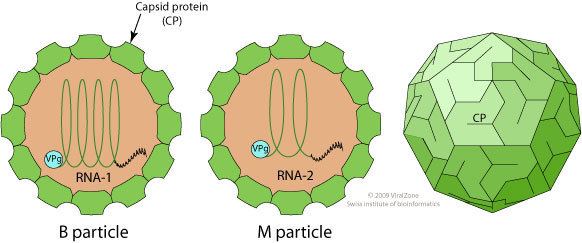Group Group IV ((+)ssRNA) Scientific name Nepovirus Rank Genus | ||
 | ||
Lower classifications Grapevine fanleaf virus, Tomato ringspot virus, Tobacco ringspot virus, Tomato black ring virus, Peach rosette mosaic vi | ||
Nepovirus is a genus of viruses in the order Picornavirales, in the family Secoviridae, in the subfamily Comovirinae. Plants serve as natural hosts. There are currently 36 species in this genus including the type species Tobacco ringspot virus. Nepoviruses, unlike the other two genera (Comovirus and Fabavirus) in the subfamily Comovirinae, are transmitted by nematodes.
Contents
Taxonomy
Group: ssRNA(+)
Structure
Viruses in Nepovirus are non-enveloped, with icosahedral geometries, and T=pseudo3 symmetry. The diameter is around 28-30 nm. Genomes are linear and segmented, bipartite, around 23.9kb in length.
Life Cycle
Viral replication is cytoplasmic. Entry into the host cell is achieved by penetration into the host cell. Replication follows the positive stranded RNA virus replication model. Positive stranded RNA virus transcription is the method of transcription. The virus exits the host cell by tubule-guided viral movement. Plants serve as the natural host. The virus is transmitted via a vector (nematodes, mite, and thrips). Transmission routes are vector.
Genome
Nepoviruses are classified as type IV viruses under the Baltimore classification system, and consequently contain bipartite, linear, single stranded positive sense RNA genomes. The two genome segments are encapsulated separately into two different icosahedral particles. Each of the genome segments produces a different polypeptide, which undergoes a series of steps (i.e. proteolysis, and other post-translational modifications) in order to produce a functional protein.
RNA1
The first segment (RNA1) is approximately 8,000 nucleotides in length and appears as a single copy in each B type virion. It encodes the proteins that are important in replication and is the first gene to be activated.
RNA2
The second segment (RNA2) is approximately 4,000–7,000 nucleotides in length and usually appears as a single copy in each M type virion. It encodes the proteins that are important in cell-cell transmission and evasion of cellular defenses.
